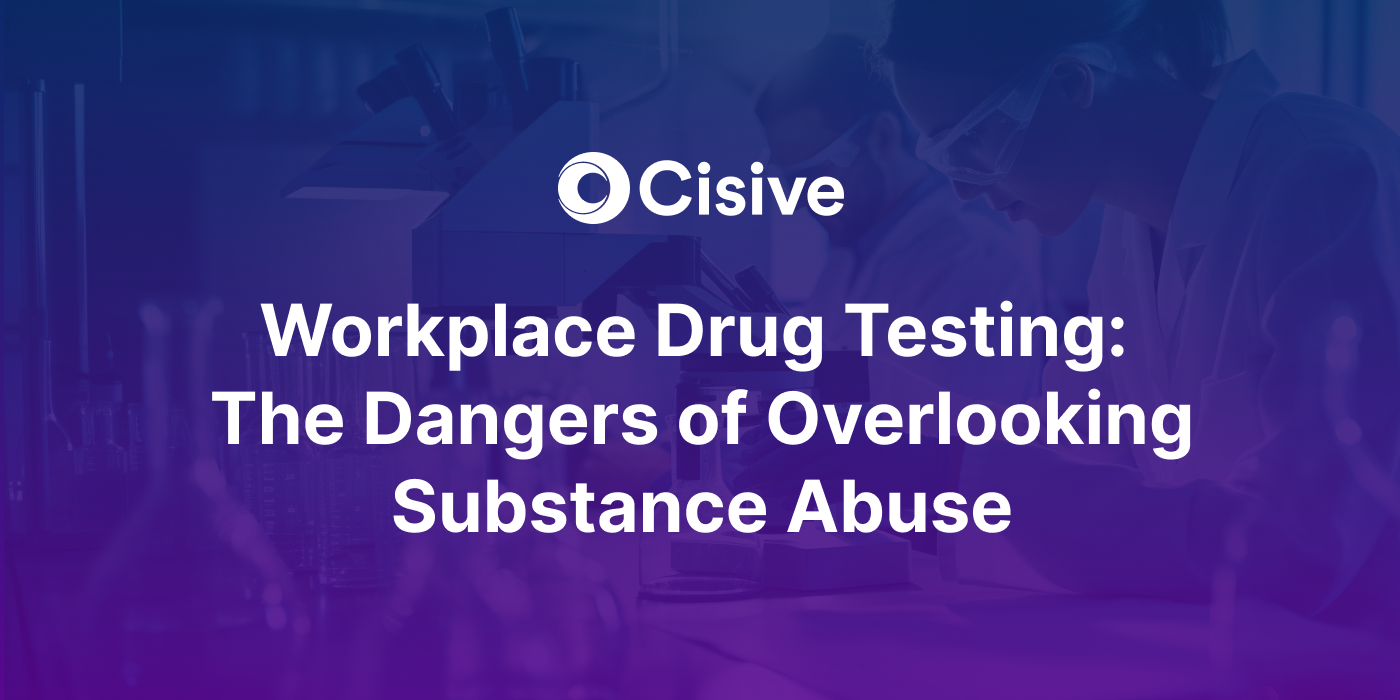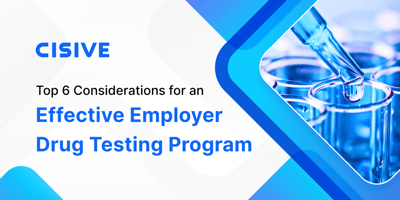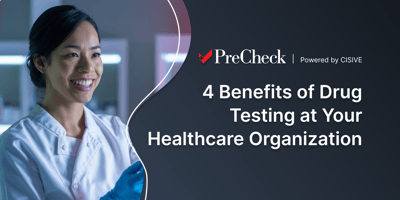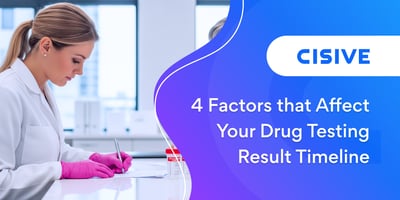

Employer drug testing is pivotal to ensuring workplace safety, mitigating risks and costs,...

As the nation works to climb out of the opioid epidemic, employers are left to navigate an onslaught of legal marijuana laws throughout the U.S. with testing limitations never seen before, paired with the challenge of a dwindling job applicant pool; some employers are considering whether they should continue to conduct screening for marijuana or challenging the idea of performing drug testing in their workplaces altogether.
Is there still a benefit to having a comprehensive drug-free workplace program? In short, the answer is a resounding "YES!"
Why? Because the risks of not testing are real. There is no mystery why this is so; look at the latest facts, statistics, and financial impacts.
Key Takeaways
|
Drug testing in the U.S. workplace is now about a generation old. Beginning in earnest during the late 1970s in response to what was then referred to as an "epidemic" of illegal drug use.
One of the earliest reported drug test-positive rates in the country was 13.6% of the combined United States workforce.
Because of the broad-based implementation of employee drug testing throughout the 1990s, the annual positivity rate dropped to 3.5% (combined U.S. workforce) in 2012. Data that undisputedly indicates workplace drug testing programs work!
Since the inception of testing programs, the value of pre-employment drug testing, as well as for current employees, has been hotly debated. Indeed, no reasonable person would condone illegal drug use in the workplace; likewise, no one could deny that illicit drug use occurs at work or that off-duty use of legal or illicit drugs has some impact on the workplace.
Over the years, there have been different points of view about the need for workplace-related drug testing.
Some have argued that drug testing is an invasion of privacy, others have questioned the accuracy of the test methods used and whether it is worth the cost, and still, others have challenged the use of drug testing on moral grounds.
Unfortunately, the trend of workplace substance use is only increasing.
According to the latest data from Quest Diagnostics, one of the largest laboratories conducting workplace drug screening, analyzing approximately 12 million test events annually, the combined workforce positive rate for all substances is now at a twenty-year high of 4.6 percent.
The opioid epidemic has hit our nation hard. The workplace was not shielded from the impacts of this epidemic.
One recent study showed that more than 1 million people have died since 1999 from a drug overdose. More than 75% of drug overdose deaths in 2021 involved an opioid.
The Bureau of Labor Statistics reported that overdose deaths at work increased by an alarming 25%. The number of overdose deaths involving opioids, including prescription opioids, heroin, and synthetic opioids (like fentanyl), in 2021 was ten times the number in 1999. Overdoses involving opioids killed more than 80,000 people in 2021, and nearly 88% of those deaths involved synthetic opioids.
Public opinion on marijuana legalization has increased significantly, with most Americans (88%) believing marijuana should be legal compared to 12% back in 1970.
States and municipalities continue to adopt or revise medical or adult-use marijuana laws – nearly every state now has some form of lawful access to marijuana.
This trend has clearly shown impacts on the workplace. Again, referencing the latest data from Quest Diagnostics, the drug testing positivity rate for marijuana in the general workforce increased by more than 53% (2012-2022). The positive test rate for marijuana in federally-regulated testing also showed an increase, which historically held steady.
In states with legal adult use of marijuana, the positivity rate increased by more than 118%; in states with medical use of marijuana, the positivity rate increased by nearly 70% between 2012 and 2020.
In states with no legalized use of marijuana, the positivity rate increased by almost 60%. The most impactful (but not surprising) stat shows that marijuana positives for post-accident testing increased more than 204% from 2012-2022.
Opioids and marijuana were not the only culprits driving up the overall positivity rates. Amphetamine and cocaine also showed increased use.
Adding more “fuel to the fire,” another recent study shows that nearly 7 in 10 Americans used drugs while they were working. Most respondents said they used drugs on the way to work or at lunch breaks. The car in the parking lot or the bathroom were the most common places to use drugs.

Substance use disorders (SUDs, the preferred term for addiction) are among the most common and costly health conditions affecting Americans.
Yet despite estimates from the Recovery Centers of America that the economic cost of SUD in the United States is approximately $3.73 trillion annually, employers may not see how substance use, in general and diagnosable substance use disorders, impacts their workplace or bottom lines.
SUD comes with numerous personal costs, of course: poor health, broken relationships, financial hardships, and more. But one's actions extend to those who employ them, companies large and small.
Seventy percent of people who use illegal drugs are employed either full or part-time, and 1 in 10 adults have had or will have a diagnosable SUD in their lifetime. A full 75 percent do not receive any form of treatment. It is critical to examine these implications for the workforce.
The National Council on Alcoholism and Drug Dependence (NCADD) estimates that SUD costs employers $81 billion annually through lost productivity and absenteeism, turnover and recruitment costs, workplace accidents, health care expenses, and disability and workers' compensation.
In addition, according to NCADD, SUD can affect the workplace through:
Overall, company morale, interpersonal work relations, and teamwork likely also pay the price.
With more access to "drugs of abuse," it would seem like a no-brainer to conduct testing, but with the complications in establishing and maintaining a drug-free workplace, how do you measure the value of a drug and alcohol testing program in your workplace?
The answer will vary for each workplace.
For as long as there has been drug testing in the United States workplace, there have been those asking if it's worth it. Each employer needs to decide what "it" is without getting too philosophical. What does the company expect from a drug and alcohol testing program? Some goals to consider are:
These are all legitimate and valuable goals of any workplace drug testing program. When done correctly, employees' privacy concerns, the accuracy of the test methods used, and the return on your investment can be recognized.
You must have a comprehensive, compliant and balanced program to achieve your company's drug prevention goals.
Robert Dupont, MD, one of the first Directors of the National Institute on Drug Abuse (NIDA), wrote, "For drug testing to fulfill its promise as a vital part of the effort to end the drug abuse epidemic, it is essential that the tests be reliable so that people who are not using drugs are not falsely accused and that legitimate medical use of controlled substances not expose employees to harassment or labeling as drug abusers."
Dr. DuPont said it was necessary to instill confidence in any drug and alcohol testing program. To do so, a testing program should have the following:
The foundation of any workplace drug testing program is a combination of the company's policy and its implementation procedures. The policy must consider the who, what, where, when, and how of testing and the consequences of any policy violation.
Who will be tested? Will you test all employees? Do you have employees whose functions are regulated by a federal or state agency? Are there state laws that specify who you may test? Are your employees represented by a collective bargaining agreement (Union)?
What substances will you test? Will you conduct the industry standard 5-panel or 10-panel substances, or include testing for other drugs? Do state laws impact what substances you can screen? Should you drop marijuana from the panel of drugs?
Nearly five years after the use of marijuana became legal in Colorado, a survey conducted by the Mountain States Employers Council found that almost 70 percent of the 609 employers responding performed drug testing, and nearly all tested for marijuana. It was found that:
Where will testing be conducted? Will you use a certified laboratory, conduct testing on-site, or both? Are there rules in the state that you operate in that mandate how testing is performed?
When will testing be required? Perhaps the most important consideration is when you will require employees to submit to a test. Will you test all those applying for a job? Will you include reasonable suspicion, post-accident, or random testing? Are there state laws that prohibit you from screening in specific situations?
Each test event has significant issues that should be carefully considered before finalizing your decisions.
How will testing be conducted? This issue involves considering the most appropriate test method for your company. Will you test using urine, blood, oral fluid (saliva), or hair? Will you utilize a different testing method or testing panel pre-hire versus post-hire? Which test method(s) are permitted in your state? Can you use an on-site or instant test screening device?
What discipline will you impose if someone violates your company's policy? Will you offer an opportunity for treatment? A second chance agreement? Are there any state limitations on the actions you wish to impose for policy violations?
The task of sorting out these details may seem too much to deal with and not worth the effort. Considering the realities of the statistics we have already discussed, can you risk being the workplace in your area that potential employees know does not conduct drug tests?
Also, consider that the apparent complexities of establishing and maintaining your company's drug testing program, policy, related procedures, job descriptions, supervisor training, and employee handbooks are your blueprint for protection!
If you build a compliant testing program, your goals can be achieved.
Lastly, employers can and should take advantage of the financial rewards recognized by defending unemployment claims and by being able to raise appropriate defenses to workers' compensation claims and reducing workers' compensation premiums in many states that offer such benefits.
There are 19 states today that have enacted affirmative defenses (rebuttable presumption of Intoxication as one example) to a workers' compensation claim – using a drug test result to deny a claim (so long as you followed all the rules).
Many employers have seen significant value and reap the rewards of a compliant workplace screening program by being prepared to defend these claims properly.
Perhaps the most impactful reason to establish a workplace screening program is the obligation for employers to foster a safe & productive workplace. The principal concept of safety is accepted across the nation in general but also federally recognized by the Occupational Safety and Health Administration's (OSHA) "General Duty Clause," which reads in part:
29 U.S. Code § 654 - Duties of employers and employees
(a)Each employer—
(1) shall furnish to each of his employees employment and a place of employment which are free from recognized hazards that are causing or are likely to cause death or serious physical harm to his employees;
(2) shall comply with occupational safety and health standards promulgated under this chapter.
(b) Each employee shall comply with occupational safety and health standards and all rules, regulations, and orders issued pursuant to this chapter which are applicable to his own actions and conduct.
Employers must carefully consider the pros and cons of establishing a drug and alcohol testing program specific to their workplace. Most employers would agree that the pros far outweigh the cons. Ensuring a safe workplace must be considered a top priority for any organization, and substance abuse screening is crucial.
Partnering with a highly credentialed background screening company like Cisive can streamline your drug testing process, ensuring compliance and accuracy.
Cisive's expertise in navigating the complexities of state laws and regulations provides peace of mind and safeguards your company against potential legal challenges. Their comprehensive suite of services offers tailored solutions that meet your company's specific needs, making them an invaluable ally in maintaining a safe and productive workplace. Speak to an expert to get started today!
Author: Jessica McDonald
Bio: Product Strategy and Development, Drug Testing and Occupational Health Subject Matter Expert at Cisive
Let's Connect on LinkedIn
Employer drug testing is pivotal to ensuring workplace safety, mitigating risks and costs,...

Drug testing in the healthcare industry is standard practice for many organizations, including...

Using drug testing during the hiring process gives you the information you need to make a good...